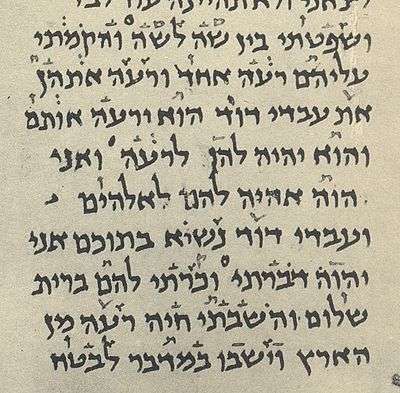Babylonian vocalization


The Babylonian vocalization, also known as Babylonian supralinear punctuation, or Babylonian pointing or Babylonian niqqud Hebrew: נִקּוּד בָּבְלִי) is a system of diacritics (niqqud) and vowel symbols devised by the Masoretes of Babylon to add to the consonantal text of the Hebrew Bible to indicate the proper pronunciation of words (vowel quality), reflecting the Hebrew of Babylon. The Babylonian system is no longer in use, having been supplanted by the Tiberian vocalization system.
History
The simple Babylonian vocalization system was created between the 6th and 7th centuries, while the complex system developed later.[1] There is evidence that Babylonian Hebrew had emerged as a distinct dialect by the end of the 9th century.[2] Babylonian Hebrew reached its peak in the 8th to 9th centuries, being used from Persia to Yemen.[3] Under Muslim hegemony in the 10th century, the main academies disappeared and the Babylonian vocalization was replaced by the Tiberian vocalization.[3] However, contemporary Yemenite Hebrew is thought to be the descendent of a variety of Babylonian Hebrew, as represented in the Babylonian system.[4] The first example of the Babylonian vocalization to become known to modern scholars was a codex of the Prophets discovered in 1839 at Chufut-Kale.[5]
Description
The Babylonian vocalization, along with the Palestinian vocalization, are known as the supralinear vocalizations because they place the vowel graphemes above the consonant letters, rather than both above and below as in the Tiberian system.[6] As in the Palestinian vocalization, only the most important vowels are indicated.[7]
Two Babylonian systems developed: an earlier simple (or einfach, E) system, and a later complex (or kompliziert, K) system.[8] The following vowel graphemes were used in the simple system:[9]
| niqqud with ב | |
|
|
|
|
|
|
| Tiberian analogue |
patah, segol |
qamatz | tzere | hiriq | holam | qubutz, shuruq |
shva mobile (shva na) |
| value | /a/ | /ɔ/ | /e/ | /i/ | /o/ | /u/ | /ə/ |
The simple system also has signs corresponding to Tiberian dagesh and rafe, though not used identically.[9] Shva quiescens (shva nah) is unmarked.[9]
The complex system may be subdivided into perfect and imperfect systems.[9] The former, unlike the latter, "has special signs for each kind of syllable and uses them consistently."[9] It marks allophones of /a e i u/, consonant gemination, distinguishes vocalic and consonantal א and ה, and marks shva mobile and quiescens with a single grapheme.[8]
A number of manuscripts with features indermediate between Tiberian and Babylonian also exist.[10] Later Yemenite manuscripts, using both simple and complex systems, show Yemenite features such as confusion between patah and shva and between tsere and holam.[10]

Cantillation
The Babylonian system uses cantillation similarly to the Tiberian system.[11] The oldest manuscripts (which use the simple system) mark only disjunctive accents, do not write the accent over the stressed syllable, and do not mark mappiq, while later manuscripts do.[11]
See also
References
- ↑ Sáenz-Badillos (1993:98)
- ↑ Sáenz-Badillos (1993:94)
- 1 2 Sáenz-Badillos (1993:103)
- ↑ Sáenz-Badillos (1993:104)
- ↑ Sáenz-Badillos (1993:95)
- ↑ Blau (2010:7)
- ↑ Sáenz-Badillos (1993:118)
- 1 2 Sáenz-Badillos (1993:97–98)
- 1 2 3 4 5 Sáenz-Badillos (1993:97)
- 1 2 Sáenz-Badillos (1993:99)
- 1 2 Sáenz-Badillos (1993:100–101)
External links
Bibliography
- Blau, Joshua (2010). Phonology and Morphology of Biblical Hebrew. Winona Lake, Indiana: Eisenbrauns. ISBN 1-57506-129-5.
- Sáenz-Badillos, Angel (1993). A History of the Hebrew Language. Cambridge University Press. ISBN 0-521-55634-1.